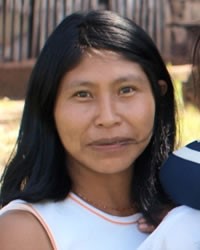Pai Tavytera in Paraguay

Photo Source:
Wayne Goddard
|
Send Joshua Project a map of this people group.
|
| People Name: | Pai Tavytera |
| Country: | Paraguay |
| 10/40 Window: | No |
| Population: | 15,000 |
| World Population: | 15,000 |
| Primary Language: | Pai Tavytera |
| Primary Religion: | Ethnic Religions |
| Christian Adherents: | 14.00 % |
| Evangelicals: | 3.00 % |
| Scripture: | Translation Needed |
| Ministry Resources: | No |
| Jesus Film: | No |
| Audio Recordings: | Yes |
| People Cluster: | South American Indigenous |
| Affinity Bloc: | Latin-Caribbean Americans |
| Progress Level: |
|
Introduction / History
The Kaiwa Pai Tavytera live between the Apa and Jejuí rivers and in the upper Ypané and upper Aquidabán rivers. They are grouped in 39 communities in the departments of Amambay (mainly, districts of Pedro J. Caballero, Bella Vista and Capitán Bado). Concepción (districts of Concepción, Horquetae Yby Yaa'ú), San Pedro (district of Guayaibi) and Canindeyú (districts of Ygatymí and Itanará).
They speak Pai Tavytera, but most also speak Guarani and possibly Spanish.
What Are Their Lives Like?
Their culture is somehow concentrated around and from the hills. Among them is in the first place the Guazú Hill, which in the language is known as Jasuka Venda or Karavíe Guazu. This hill, which is actually a group of smaller hills, is considered the center of the world, the place of the gods, the main origin of the entire cosmos.
They live in deep religious harmony with the earth; everything related to crops, harvesting, food system, animal and forest management has a religious background; the gods are the owners of everything and they set cultural guidelines to preserve harmony vertically (person-gods) and horizontally (person-person and person-nature).
All the communities now have a mixed economy, that is to say, they have traditional crops, raise animals and also do changa work (transitory salaried activity). The point of reference is always the community, since they do not go away for a long time, at the most they go for a few weeks to clean the forest, work as axemen, caretakers of estancias, etc. The women who live near Paraguayan towns also do laundry work, sell medicinal herbs or farm products at home and in the small local markets. They also now raise chickens and ducks. They use the horse as a means of locomotion and as a working tool in livestock farming.
What Are Their Beliefs?
They practice their own ethnic religion. They are great theologians, who elaborated a profound doctrine on the origin of the world, of people and of all things. The spirits exist since the beginning of time in their Amba, without evil or stain. When they arrive on earth, they become infected and that is why they need to continue to purify themselves for the return to the Amba. At the moment of death, when the breathing stops, the tupâ loses the body and tries to return to the Amba, going through several stages. With the first divine being, the vera and the mimby also appeared; from the vera, the spirits of the gods and the human beings (tupâ) came out; from the mimby, the luminosity and all the beings that produce it came out. After a meeting that Nane Ramoi Jusu Pa Pa (commonly called Nanderu) had with the other gods about the need for a better illumination in the world, all were throwing into the universe their fragments of luminous bodies and thus emerged the sun, the moon and the stars.
What Are Their Needs?
There are a number of solid believers both on the Paraguay and Brazil side. The need is to see these believers equipped to reach their own people in a culturally relevant way.
Prayer Points
Pray for pastors and leaders of the local churches to have wisdom and knowledge of the Word of God to guide the believers.
Pray for local churches and their growth to maturity.
Pray for the missionaries who work with them.
May workers be raised up to bring the good news to the communities that do not yet have the gospel.